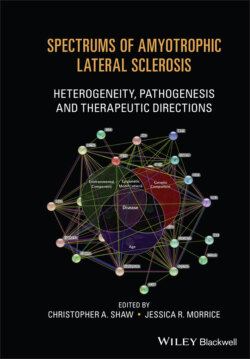Читать книгу Spectrums of Amyotrophic Lateral Sclerosis - Группа авторов - Страница 18
ALS and Its Relationship with Frontotemporal Dementia and Myopathies
ОглавлениеALS has long been considered a paradigm of pure motor neuron disorder. However, genetic discoveries have shown that other cell types may be involved, linking ALS to other diseases. The most common and well‐established condition connected with ALS is frontotemporal dementia (FTD). Frontotemporal lobar degeneration (FTLD) consists of the degeneration of the frontal and temporal lobes of the brain, leading to atrophy, and occurs with an incidence of 3.5–4.1/100 000 per year in individuals under 65 [16, 17]. Clinically, this is the second most common cause of early‐onset dementia, referred to as FTD, and is familial in 20–30% of cases. Variants of FTLD have been described based on clinical signs. Behavioral variant frontotemporal dementia (bvFTD) is the most frequent form and is characterized by behavioral problems – apathy and disinhibition – and a decline in executive functions. Progressive nonfluent aphasia (PNFA) is characterized by language problems including nonfluent speech, dysarthria, poor articulation, and agrammatism with preserved comprehension. The third variant is semantic dementia (SD), also called progressive fluent aphasia (PFA), characterized by the loss of semantic and conceptual knowledge. All these FTLD variants have been described in patients with ALS.
Insoluble proteins aggregate in the neurons of patients with FTLD, leading to three different pathological variants: FTLD‐Tau, characterized by the accumulation of the microtubule‐associated protein and often by mutations in the gene encoding for the same protein (MAPT) (~30–40% of cases) [18]; FTLD‐FUS, containing the FUS sarcoma protein (~10% of cases) [19]; and the most frequent, FTLD‐TDP, with TDP‐43 aggregates (~50–60% of cases) [18–21].
From a clinical point of view, FTD and ALS overlap since 15–18% of ALS patients have FTD and 15% of FTD patients show motor dysfunctions [22, 23]. ALS and FTD also share genetic and neuropathological features, thus leading to the definition of the ALS/FTD spectrum where ALS and FTD are the extremes of a continuum. From a genetic point of view, this idea has been consolidated by the identification of the gene C9orf72 [24, 25], whose pathogenic expansion has been described in 30–50% of fALS, 25% of familial FTD, 5–7% of sALS, and 6% of sporadic FTD cases in different populations [26, 27]. Furthermore, other genes have been associated with the ALS/FTD spectrum: TBK1, TARDBP, FUS, and SQSTM1 [28]. Finally, with regard to neuropathology, TDP‐43 inclusions in neuronal cells are a hallmark of ALS as well as of a proportion of FTD.
Recent genetic evidence, along with clinical and pathological observations, indicate that ALS may be linked to primary muscle disorders as well. Mutations in valosin‐containing protein (VCP), previously identified in a proportion of patients with hereditary inclusion‐body myopathy (IBM), were later detected in a subset of sALS and fALS cases [29]. Additional genes, including MATR3, hnRNPA1, hnRNPA2B1, and SQSTM1, have been identified, which are responsible for an ALS/myopathy spectrum with overlapping phenotypes [30–32]. Interestingly, most myopathies associated with ALS are distal myopathies with evidence of rimmed vacuoles at muscle biopsy. These structures represent the accumulation of autophagic vacuoles due to lysosomal dysfunction or protein accumulation.
Paget's disease of the bone, extrapyramidal syndromes, psychiatric disorders, and peripheral neuropathies are additional conditions that are mechanistically linked to ALS. The spectrum of clinical phenotypes associated with major ALS‐associated genes is listed in Table 1.1 [24, 25, 29, 30,32–66].
